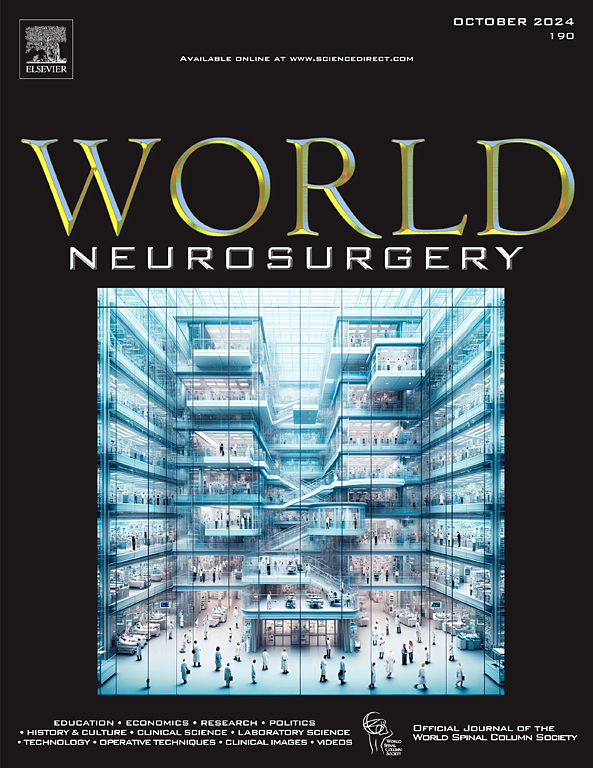Spinal Cord Injury in the 21st Century Part I: A New Demographic
IF 1.9
4区 医学
Q3 CLINICAL NEUROLOGY
引用次数: 0
Abstract
Background
Guidelines for the management of acute spinal cord injury are based on a young age group suffering spinal fracture dislocations caused by high-impact trauma. The purpose of this study was to characterize our recent cervical spinal cord injury (cSCI) experience and compare it to this traditional demographic. We hypothesized that most cSCI patients now fall outside the scope of published guideline principles.
Methods
Cross-sectional cohort study. A detailed review was performed of cSCI patients admitted to our level 1 trauma institution over a 12-month period identifying demographics, injury types, and coded diagnoses cross-referenced from multiple archival systems
Results
Fifty-one patients with cSCI from blunt trauma were identified over the 1-year study period of which 82% did not have a spinal fracture or dislocation. cSCI patients without fracture/dislocation were older (mean age 62), had low-impact injuries (93%), and lower American Spinal Injury Association grades (98%). Patients with fracture/dislocation were younger (mean age 48), had high-impact injuries (77%), and higher American Spinal Injury Association grades (66%). Ninety-eight percent of our cSCI patients without fracture/dislocation presented with sensory and motor changes preferentially involving hands and arms in contrast to 11% of patients with fracture dislocation (P < 00001).
Conclusions
cSCI patients without fracture/dislocation now represent the large majority of spinal cord injuries at our level I trauma center. The demographic is most consistent with central cord syndrome, implicating unique pathophysiology and natural history. Extrapolation of management principles from previous guideline efforts is not intuitively generalizable to this patient population.
21世纪的脊髓损伤第一部分:新的人口统计学。
背景:急性脊髓损伤的治疗指南是基于高冲击创伤引起的脊柱骨折脱位的年轻年龄组。本研究的目的是描述我们最近的颈脊髓损伤(cSCI)经验,并将其与传统的人口统计学进行比较。我们假设大多数cSCI患者现在不在已发表的指导原则的范围之内。方法横断面队列研究。对我们的一级创伤机构在12个月内收治的cSCI患者进行了详细的回顾,确定了人口统计学、损伤类型和多个档案系统交叉引用的编码诊断。结果在1年的研究期间,51例钝性创伤cSCI患者被确定,其中82%没有脊柱骨折或脱位。无骨折/脱位的cSCI患者年龄较大(平均62岁),有低冲击性损伤(93%),美国脊髓损伤协会评分较低(98%)。骨折/脱位患者较年轻(平均48岁),有高冲击性损伤(77%),美国脊髓损伤协会评分较高(66%)。98%无骨折/脱位的cSCI患者表现为感觉和运动改变,优先涉及手部和手臂,而骨折脱位患者的这一比例为11% (P <;00001)。结论:在我们的一级创伤中心,无骨折/脱位的脊髓损伤患者占脊髓损伤的绝大多数。人口统计学与中枢脊髓综合征最一致,暗示独特的病理生理和自然历史。从以前的指南工作中推断出的管理原则并不能直观地推广到这一患者群体。
本文章由计算机程序翻译,如有差异,请以英文原文为准。
求助全文
约1分钟内获得全文
求助全文
来源期刊

World neurosurgery
CLINICAL NEUROLOGY-SURGERY
CiteScore
3.90
自引率
15.00%
发文量
1765
审稿时长
47 days
期刊介绍:
World Neurosurgery has an open access mirror journal World Neurosurgery: X, sharing the same aims and scope, editorial team, submission system and rigorous peer review.
The journal''s mission is to:
-To provide a first-class international forum and a 2-way conduit for dialogue that is relevant to neurosurgeons and providers who care for neurosurgery patients. The categories of the exchanged information include clinical and basic science, as well as global information that provide social, political, educational, economic, cultural or societal insights and knowledge that are of significance and relevance to worldwide neurosurgery patient care.
-To act as a primary intellectual catalyst for the stimulation of creativity, the creation of new knowledge, and the enhancement of quality neurosurgical care worldwide.
-To provide a forum for communication that enriches the lives of all neurosurgeons and their colleagues; and, in so doing, enriches the lives of their patients.
Topics to be addressed in World Neurosurgery include: EDUCATION, ECONOMICS, RESEARCH, POLITICS, HISTORY, CULTURE, CLINICAL SCIENCE, LABORATORY SCIENCE, TECHNOLOGY, OPERATIVE TECHNIQUES, CLINICAL IMAGES, VIDEOS
 求助内容:
求助内容: 应助结果提醒方式:
应助结果提醒方式:


